Goodness of Elements for Goodness of Cows
Trace Minerals
As the name implies, even small amounts of these nutrients have a large and diverse effect on the animal’s health and productivity.
You are viewing Asia Pacific
KEMTRACETM Minerals
As the name implies, even small amounts of these nutrients have a large and diverse effect on the animal’s health and productivity.
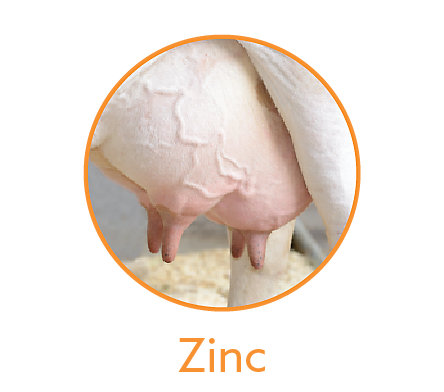
is a component of more than 300 enzymes and hormones and play an important role in metabolism. In particular, protein biosynthesis and the regulation of gene activity can be affected by zinc.
Zinc deficiency can cause poor growth, loss of appetite and a bad feed conversion rate.
Due to its crucial function in defence enzyme (copper-zinc superoxide dismutase), zinc deficiency reduces resistance. In dairy cows, zinc deficiency is visible through poor hoof health, reduced fertility and poor udder health.
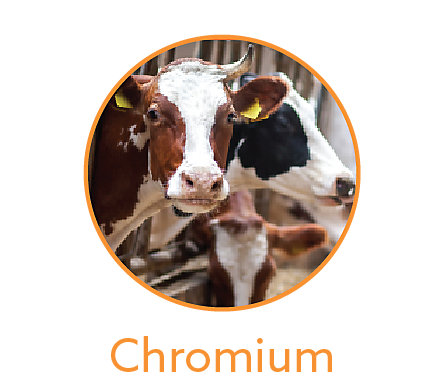
is involved in the Glucose Tolerance Factor (GTF) as an organometallic molecule (chromodulin), which activates tyrosine kinase at the insulin receptor, which amplifies insulin sensitivity and thus cellular glucose uptake.
By enhancing the availability of glucose, the animal has more energy to help with maintenance, reproduction, growth, performance and immunity.
Chromium deficiency in dairy cows can lead to impaired glucose tolerance, hyperglycaemia and relative insulin resistance.
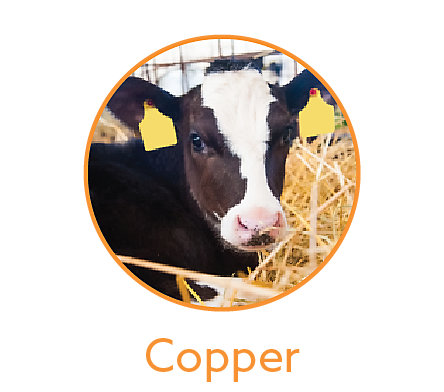
is heavily involved in the utilization of iron and thus the synthesis of haemoglobin. In addition, the pigmentation of the hair coat is fundamentally influenced by copper levels. Through the promotion of superoxide dismutase, which deactivates free oxygen radicals, copper is also involved in cell protection and thereby in a healthy immune system.
Copper deficiency in dairy cows is often reflected in reduced fertility and poor immunity.
If the minerals and other nutrients pass unabsorbed through the digestive system, the money spent on them is essentially wasted. Indeed, they may even become an environmental issue - mineral pollution. An ideal mineral quality and characteristics is based on following parameters:

KEMTRACE™ minerals are superior because they offer improved bioavailability relative to other mineral sources. Basically, KEMTRACE™ trace minerals source with propionic acid as organic carrier, solubilize and dissociate at the desired place in the digestive tract.
Everything starts with Solubility
In-vitro experiment was conducted to evaluate the uptake and solubility of zinc provided as KEMZIN™ 2000 Dry and zinc sulfate by caco-2 cells after ruminal and intestinal digestion.
For the uptake experiment, caco-2 cells were grown in plastic tissue culture wells using standard tissue culture method. Test solution of 200 µM zinc was prepared using KEMZIN™ 2000 Dry and Zn sulfate separately.
Research showed that zinc from KEMZIN™ 2000 Dry was more soluble than zinc sulphate; similarly zinc uptake was also greater from digestion containing 200 µM zinc from KEMZIN™ 2000 Dry.
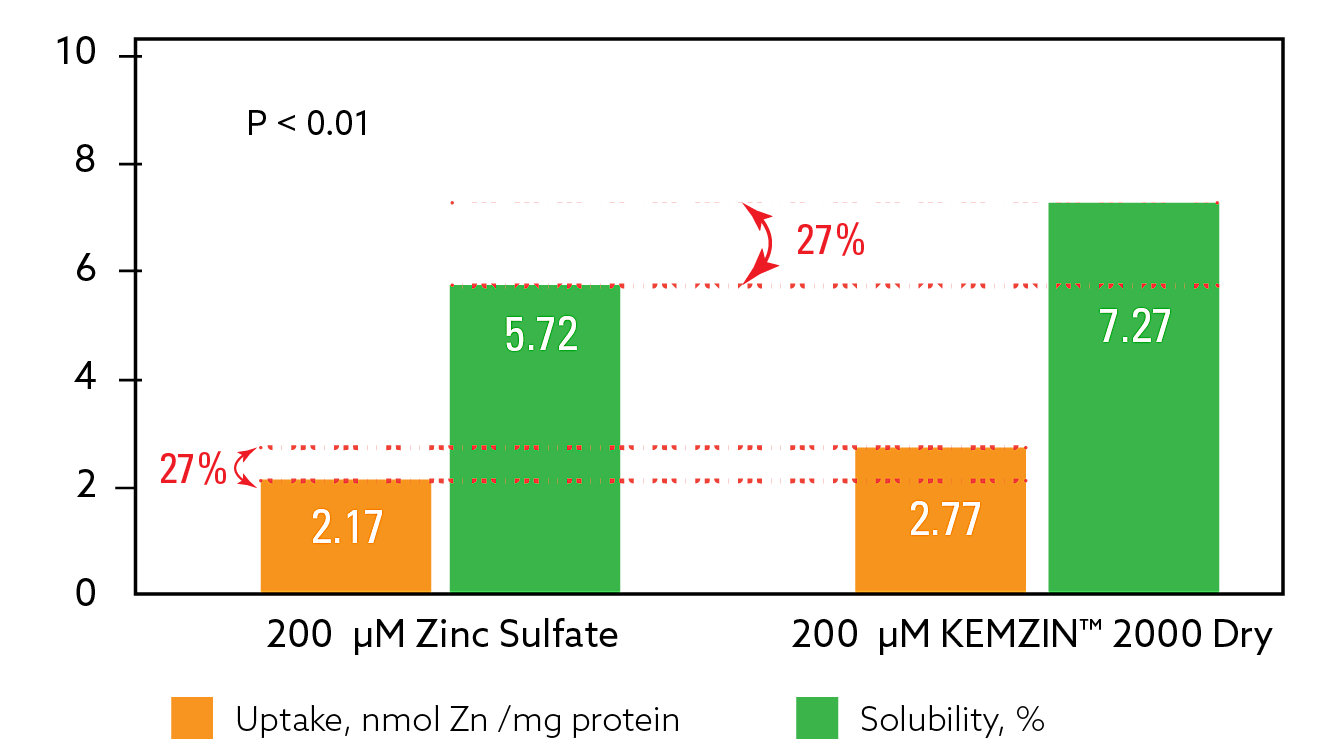
The bioavailability of zinc in ruminants is also a critical issue. Kemin did a comparative analysis of various zinc sources in dairy cows.
In an animal study, Holstein cows were fed minerals to provide 300 ppm of supplemental zinc. The zinc sources compared were zinc sulfate, zinc proteinate and KEMZIN™ 2000 Dry. There were four cows per treatment. Serum zinc concentrations were measured at 0, 4 and 8 hours post-bolusing for three days.
This graph shows the serum zinc levels from the study. Zinc sulfate and zinc proteinate were of similar bioavailability, while KEMZIN™ 2000 Dry had the highest level of bioavailability
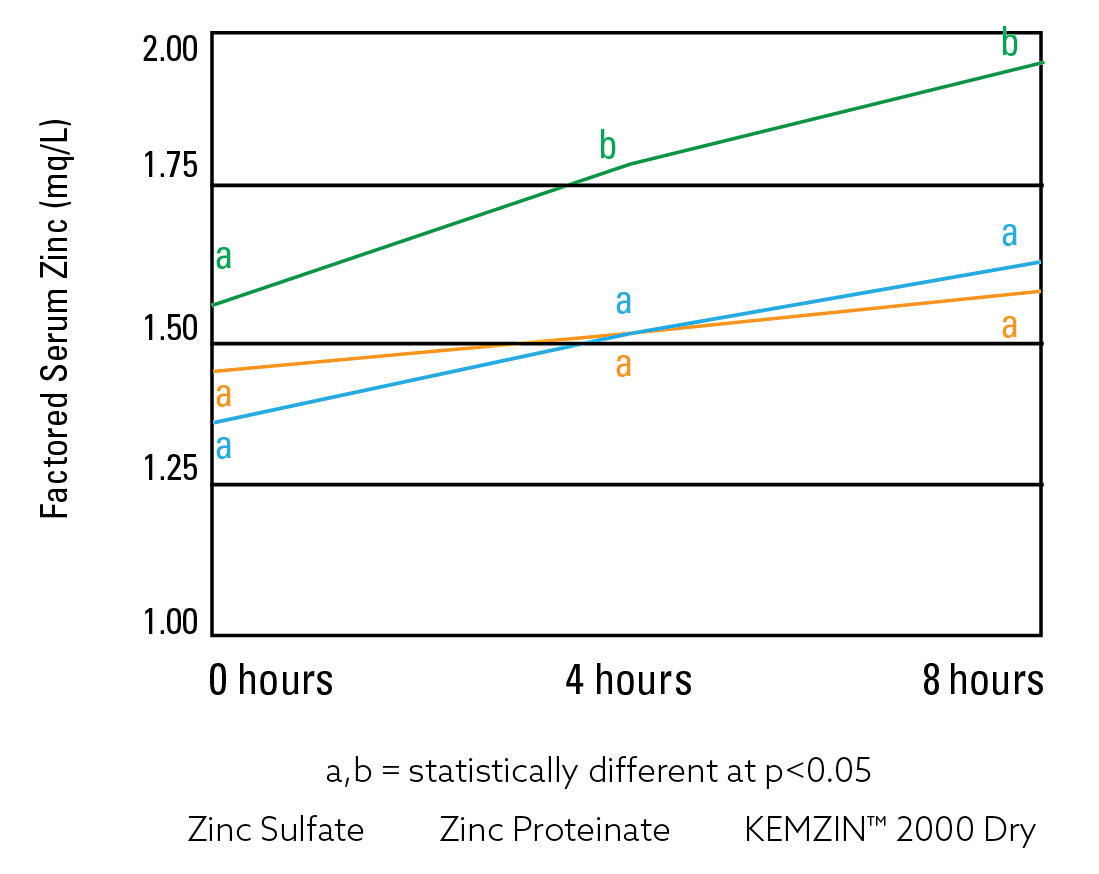
Maintaining Udder Health
A trial was conducted to compare efficacy of KEMZIN™ 2000 Dry in maintaining low somatic cell counts in herds which had been utilizing commercially available Zinc Methionine as a source of Zinc. The dairy had 400 cows. The trial began in late February and ran through late July. The herd was placed on either KEMZIN™ 2000 Dry or Zinc Methionine at the same dosage i.e. 75 mg/kg dry matter.
The trial was performed during a variety of weather conditions. The initial phase of the trial faced cold, dry weather. As the season progressed, the temperature increased. May and June were extremely wet. July began to dry down to normal summer conditions. Impact of weather and change of mineral source on Somatic Cell Count (SCC) is described in the table.
The trial demonstrated that both zinc methionine and KEMZIN™ 2000 Dry were equally efficacious in maintaining the level of SCC within acceptable ranges.
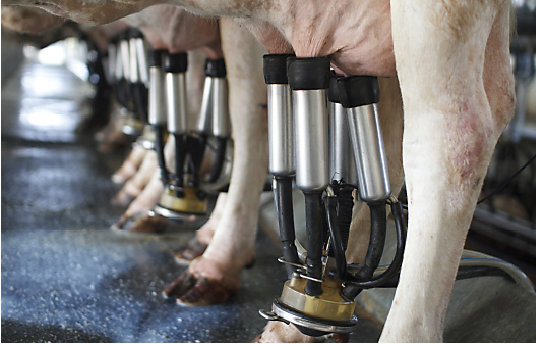
| Supplementation | Month | Average SCC (‘000) |
| Zinc Methionine | Feb 24 - March 24 | 164.8 |
| KEMZIN™ 2000 Dry | March 25 - April 24 | 146.0 |
| Zinc Methionine | April 25 - May 24 | 144.8 |
| KEMZIN™ 2000 Dry | May 25 - June 24 | 170.1 |
Improve milk yield during heat stress
The influence of chromium on milk production has been attributed to its effects on energy metabolism reflected through decreased mobilization of NEFA from adipose tissue and increased insulin sensitivity. During extended periods of heat stress at different stages of lactation, increased glucose availability and utilization may have significant benefits to milk production. Research studies designed to test the effect of chromium on milk yield under heat stress conditions have shown cows supplemented with chromium yield more than control cows.
Figure 1. Effect of chromium supplementation in lactating dairy cow diets on response in daily milk yield and dry matter intake, kg/h/d under heat stress conditions. (References are available upon request)
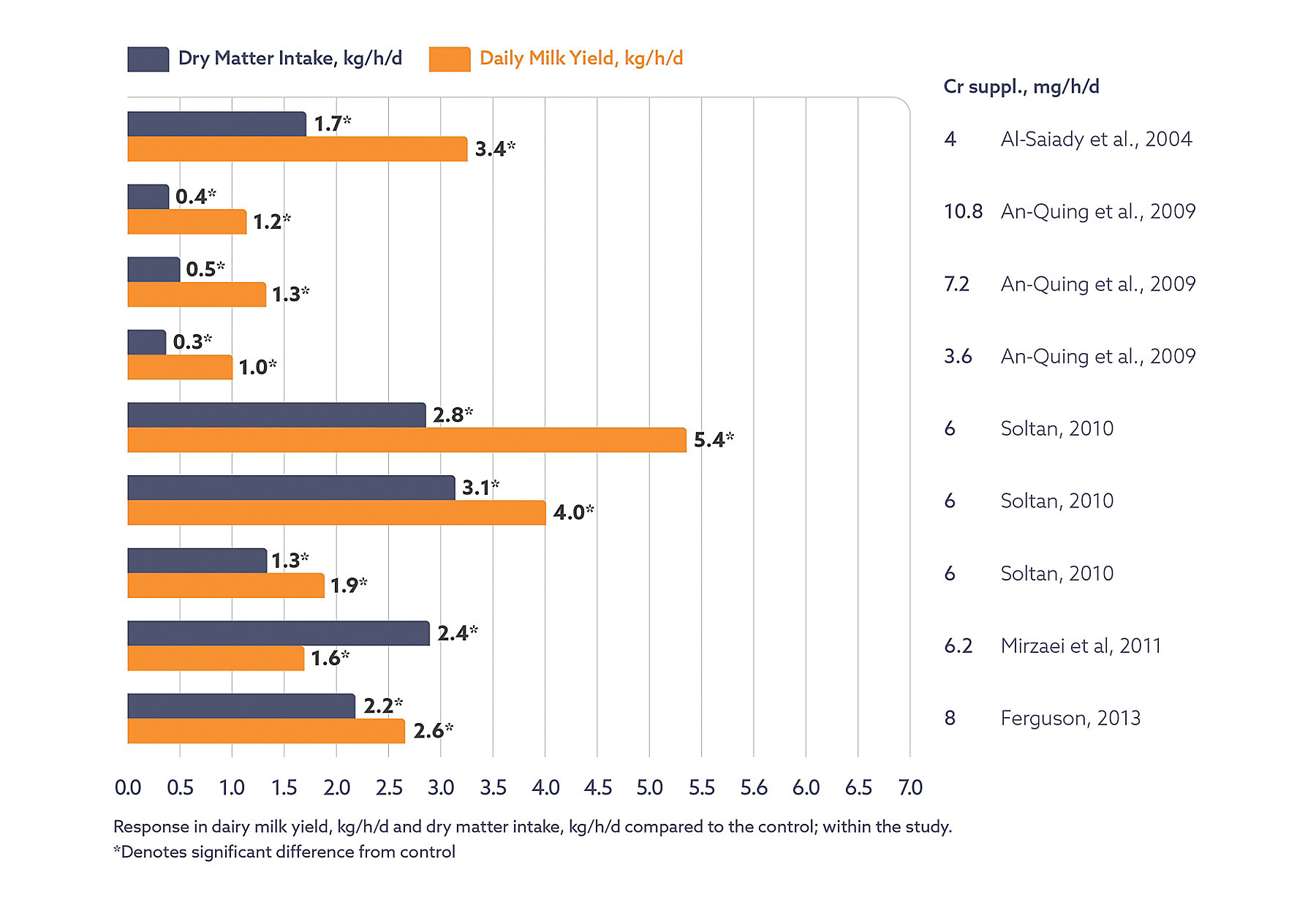
Win Fight with Enemy
An experiment was conducted on 30 Angus crossbred steers for 90 days. Two groups i.e. Control (20 animals, 0 ppm Cu) and treatment group (10 animals, 10 ppm Cu from KEMTRACE™ Cu MP) were compared.
Experimental groups were supplemented with 5 ppm of molybdenum (from sodium molybdate) and 0.15% sulfur (from calcium sulfate) as antagonist. Jugular blood samples were collected on days 0, 28, 56 and 90 for ceruloplasmin (a copper dependent enzyme) analysis.
Results indicate that in the presence of copper antagonist (molybdenum and sulfur), supplementation of copper from KEMTRACE™ Cu MP (10 ppm) to the diet resulted in maintaining plasma ceruloplasmin. However, in the control group, it was reduced.
| Parameters | KEMTRACE™ Cu MP (ppm) | |
| 0 | 10 | |
| Plasma Ceruloplasmin, mg/DL | ||
| Day 0 | 25.5 | 29.8 |
| Day 28 | 21.3 | 29.4 |
| Day 56 | 14.9 | 22.3 |
| Day 90 | 12.8 | 31.6 |



Not completely solubilize. A mineral must become soluble before it can readily dissociate, and minerals with low solubility have a relatively little chance for eventual cellular uptake.
Some mineral sources may dissociate too rapidly. If too much of a mineral dissociates in the rumen or before reaching the intestinal binding sites, the mineral may be re-complexed to form tightly bound complexes that may simply wash through the system without the mineral being utilized.
A mineral may also dissociate too late. Some minerals source that are too tightly chelated may not have a very high rate of dissociation prior to reaching the absorption sites.
Kemin offers highly bioavailable source of trial minerals in ruminant animals for various biological functions and improved animal performance.
© Kemin Industries, Inc. and its group of companies All rights reserved. ® ™ Trademarks of Kemin Industries, Inc., USA
Certain statements may not be applicable in all geographical regions. Product labeling and associated claims may differ based upon government requirements.
Your questions and feedback are important to us. Let us know how we can help you learn more about Kemin, our products, our services or our website.
Interested in starting a career with Kemin?
